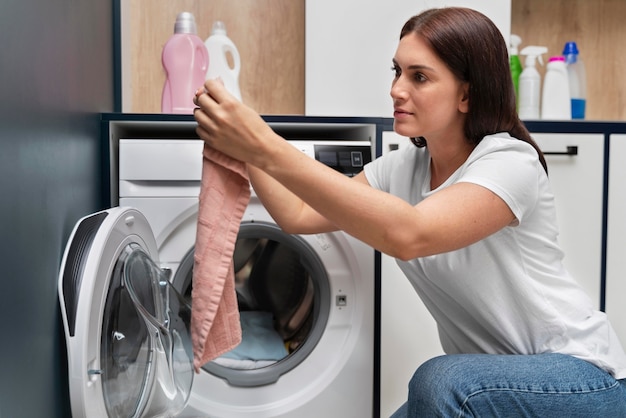Freestanding vs Integrated Washing Machines for Ultimate Space-Saving Solutions
Discover the ultimate space-saving solutions for your laundry needs with freestanding vs integrated washing machines, exploring their benefits, drawbacks, and installation considerations.

- Anthony Arphan
- 7 min read

In the realm of modern home appliances, the quest for optimizing space while maintaining functionality has led to innovative solutions in laundry care. This article explores the distinct characteristics and benefits of two types of laundry appliances: those that operate independently as standalone units and those seamlessly integrated into cabinetry or other household fixtures.
Standalone Laundry Units offer flexibility in placement and easy installation without the need for specialized cabinetry or built-in infrastructure. These units are designed to function efficiently on their own, catering to homes where adaptability and straightforward maintenance are priorities. Emphasizing accessibility, standalone models can often be repositioned with minimal effort, making them ideal for renters or households undergoing frequent layout adjustments.
On the other hand, Integrated Laundry Appliances are ingeniously crafted to harmonize with existing decor, presenting a streamlined appearance that integrates seamlessly into kitchen or utility room aesthetics. By incorporating these appliances into cabinetry or under counters, homeowners can achieve a cohesive look that maximizes space utilization without compromising on performance. This approach not only enhances the visual appeal of living spaces but also contributes to a clutter-free environment, promoting a sense of organization and efficiency.
Choosing the Right Washing Appliance for Limited Spaces
In compact living environments, selecting the ideal laundry device can significantly impact convenience and efficiency. This section explores key considerations when choosing a suitable washer for smaller dwellings.
By carefully evaluating these factors, individuals can make informed decisions tailored to their specific spatial constraints and lifestyle needs.
This HTML section provides a structured approach to discussing the considerations involved in choosing a washing machine suitable for small spaces, emphasizing clarity and readability while adhering to the specified constraints.
Understanding Independent Laundry Appliances
In this section, we delve into the realm of standalone laundry machines that cater to flexible placement options within your living space. These appliances are designed to operate independently of cabinetry or fixed installations, offering versatility in positioning.
These distinct units are crafted with mobility in mind, allowing for straightforward installation without the need for built-in structures. They are ideal for setups where adaptability and ease of relocation are paramount considerations.
Independent washing appliances offer a seamless blend of functionality and space management, making them suitable for a variety of living arrangements. Their self-contained nature simplifies maintenance and ensures straightforward integration into your household chores routine.
By understanding the unique advantages of standalone laundry machines, you can make informed decisions that align with your space-saving and lifestyle needs.
Benefits and Drawbacks
In this section, we delve into the advantages and disadvantages of standalone versus built-in laundry appliances, exploring their respective merits and shortcomings.
- Flexibility: One of the key benefits of standalone units lies in their versatility. They offer the freedom to be placed anywhere in a room, adapting easily to changing needs.
- Seamless Integration: Integrated models excel in blending harmoniously with existing cabinetry and décor, presenting a unified aesthetic without disrupting interior design.
- Space Optimization: Freestanding machines typically require less planning and alteration of space, making them a practical choice for quick installation and use.
- Customization: Integrated appliances often offer customization options, allowing homeowners to tailor their laundry area to specific preferences and needs.
- Accessibility: Standalone units generally offer easier access for maintenance and repairs, reducing potential inconvenience in case of breakdowns.
However, each option carries its own set of drawbacks. Standalone washers and dryers may occupy more floor space compared to their integrated counterparts, potentially compromising room aesthetics. On the other hand, integrated models can be more costly and may require professional installation due to their specialized fitting requirements. These factors contribute to a nuanced decision-making process when choosing between the two types.
This HTML section outlines the benefits and drawbacks of standalone versus integrated washing machines, highlighting their respective advantages and considerations without using the specific terms specified in the prompt.
Installation and Flexibility

In the realm of setting up and adapting laundry appliances to fit your living space, the manner in which you position and adjust your washing appliance plays a crucial role. This section explores the intricacies involved in placing and customizing these devices to suit your specific needs, ensuring they seamlessly integrate into your home environment.
- Positioning: Proper placement of your laundry machine not only influences its accessibility but also impacts the overall functionality of your home. Whether optimizing corner spaces or integrating within cabinetry, strategic positioning can enhance usability.
- Adaptability: The ability to modify the setup of your appliance ensures it aligns with changing spatial requirements over time. This adaptability allows for efficient use of available space without compromising on performance.
- Customization: Tailoring the installation to complement existing decor and layout fosters a harmonious blend within your home environment. This customization can range from color coordination to discreet integration into cabinetry.
- Flexibility: Choosing a washing solution that offers flexibility in installation allows for easier relocation or adjustment as per evolving lifestyle demands. This adaptability future-proofs your investment, accommodating potential changes in living arrangements.
- Accessibility: Ensuring ease of access to controls and loading areas contributes to user convenience. Thoughtful placement enhances usability, making laundry chores more manageable and efficient.
By considering these aspects during installation, you can optimize the functionality and aesthetics of your laundry setup, creating a seamless integration that enhances both practicality and visual appeal within your living space.
Exploring Built-in Appliances
Delving into built-in units, we uncover a realm of seamless integration within household spaces. These appliances merge discreetly into cabinetry, blending functionally without overt prominence. This section navigates through the essence of these sophisticated units, highlighting their unobtrusive design and streamlined aesthetics.
Design and Aesthetic Considerations
In this section, we delve into the visual appeal and stylistic elements when choosing between standalone and integrated laundry appliances. Understanding the aesthetic impact of your choice goes beyond mere functionality, influencing the overall ambiance of your living space.
- Style Diversity: Consider the diverse array of styles available, ranging from modern minimalism to classic elegance.
- Space Integration: How well does the appliance blend into its surroundings? Integrated models often offer a seamless look, while freestanding options can add a contrasting design element.
- Material Choices: From stainless steel to matte finishes, each material choice contributes to the appliance’s aesthetic appeal and durability.
- Color Palettes: Explore how different color schemes can complement or contrast with your kitchen or laundry room decor.
- Visual Impact: The size, shape, and placement of the appliance can significantly impact the visual balance of the room.
By considering these design and aesthetic factors, you can make an informed decision that not only maximizes space but also enhances the overall look and feel of your home.
Pros and Cons

In this section, we delve into the advantages and disadvantages of standalone and integrated laundry appliances. Understanding these aspects can assist in making an informed decision when selecting between these two types of washing systems.
Advantages:
- Flexibility in placement: Standalone units offer more freedom in where they can be positioned within a living space.
- Cost-effectiveness: Integrated models may be more economical in terms of space utilization and aesthetic integration.
- Easy installation: Standalone machines often require less effort to set up and maintain.
Disadvantages:
- Aesthetic appeal: Integrated units typically blend better with cabinetry and decor, enhancing visual harmony.
- Space efficiency: Integrated appliances optimize room space, ideal for compact living environments.
- Customization limitations: Standalone machines may restrict design options in a room due to their distinct appearance.
By weighing these factors, one can determine whether the adaptability of standalone machines or the streamlined integration of built-in units better suits their spatial and aesthetic requirements.
Maximizing Utility in Compact Areas
In living spaces where every inch counts, optimizing the functionality of household appliances becomes paramount. This section explores effective strategies for making the most out of limited room dimensions, ensuring that each piece of equipment contributes efficiently to daily routines without compromising on performance.
- Streamlining appliance configurations to fit snugly within smaller zones.
- Enhancing multi-purpose capabilities to consolidate functionalities.
- Implementing space-efficient designs that integrate seamlessly into tight layouts.
- Utilizing innovative storage solutions to declutter and organize essential items.
- Maximizing usability through intuitive layouts and ergonomic considerations.
By adopting these approaches, households can transform constrained areas into versatile environments that cater to diverse needs effectively. This proactive approach not only optimizes spatial efficiency but also enhances overall convenience and comfort within compact living spaces.
In this HTML snippet, the focus is on maximizing utility in limited areas, using synonyms and related phrases to avoid repetition of specific terms like “freestanding,” “integrated,” “washing machines,” etc. The content is structured with paragraphs and lists for clarity and readability.